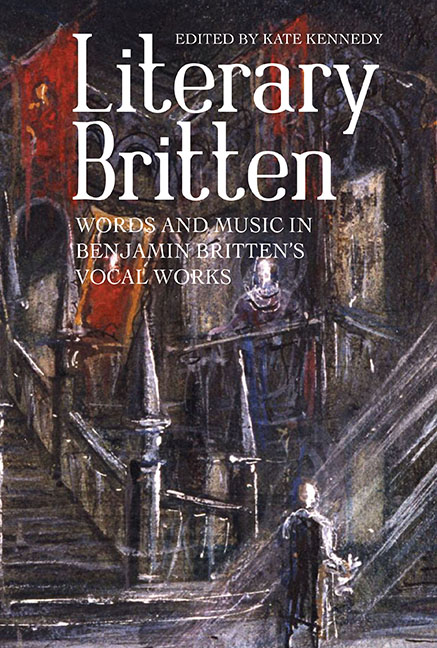Book contents
- Frontmatter
- Contents
- List of Illustrations
- List of Music Examples
- List of Contributors
- Introduction
- Part I Perspectives
- Part II Studies
- 9 Settings from Boyhood
- 10 ‘Practical Jokes’: Britten and Auden's Our Hunting Fathers Revisited
- 11 Choice and Inevitability: The Moral Economy of Peter Grimes
- 12 Sin, Death and Love: Britten's The Holy Sonnets of John Donne
- 13 Britten's Donne Meditation
- 14 Scenes from Britten's Spring Symphony
- 15 ‘I have read Billy Budd’: The Forster–Britten Reading(s) of Melville
- 16 Miles Must Die: Ideological Uses of ‘Innocence’ in Britten's The Turn of the Screw
- 17 Benjamin Britten and Medieval Drama at Chester: From Abraham and Isaac to ‘The Nativity’
- 18 Ambiguous Venice
- Bibliography
- Index
14 - Scenes from Britten's Spring Symphony
from Part II - Studies
Published online by Cambridge University Press: 17 July 2019
- Frontmatter
- Contents
- List of Illustrations
- List of Music Examples
- List of Contributors
- Introduction
- Part I Perspectives
- Part II Studies
- 9 Settings from Boyhood
- 10 ‘Practical Jokes’: Britten and Auden's Our Hunting Fathers Revisited
- 11 Choice and Inevitability: The Moral Economy of Peter Grimes
- 12 Sin, Death and Love: Britten's The Holy Sonnets of John Donne
- 13 Britten's Donne Meditation
- 14 Scenes from Britten's Spring Symphony
- 15 ‘I have read Billy Budd’: The Forster–Britten Reading(s) of Melville
- 16 Miles Must Die: Ideological Uses of ‘Innocence’ in Britten's The Turn of the Screw
- 17 Benjamin Britten and Medieval Drama at Chester: From Abraham and Isaac to ‘The Nativity’
- 18 Ambiguous Venice
- Bibliography
- Index
Summary
In his Spring Symphony of 1949 Britten approached the conventional theme of seasonal rebirth in a score juxtaposing three solo singers, chorus, boys’ choir and orchestra in an extended form of hybrid genre affiliation. Soon after the success of Peter Grimes, the thirty-two-year-old composer had, in March 1946, accepted from Serge Koussevitzky a commission for a symphony for orchestra with contralto obbligato. The project was overshadowed initially by many pressing deadlines, including the premieres of The Rape of Lucretia and Albert Herring, and a bout of illness. Plans for the piece evolved away from Koussevitzky's initial template towards an essentially choral work with soprano, alto and tenor soloists. Britten at first contemplated a selection of medieval Latin poems but ultimately turned to English poets, inspired, he reported, by the beauty of the spring in his own native Suffolk, ‘the Suffolk of Constable and Gainsborough’. Some idea of the composer's struggle with the Spring Symphony is clear in his comment to Ralph Hawkes soon after completing the sketches in March 1949: ‘I have gone through considerable agony of body and spirit through it’. That he was pleased with the variegated sequence of choral and orchestral textures that finally emerged might be guessed from a remark to his composer friend Grace Williams, that he had been ‘indulging … properly in every kind of extravagance!’. It is possible the quip reflected his excitement at returning to large-scale forces after the relative austerity of the two chamber operas, or that he was thinking about his inclusion of such exotic colours as vibraphone, temple blocks and a cow horn within the large orchestra. The comment, equally, says something about the diverse nature of the work's forty-five-minute scheme, a sequence of twelve separate sections for shifting and distinctive vocal and instrumental groupings, with the full weight of the choral and orchestral tutti heard only in the framing Introduction and Finale.
Britten himself publicly remarked on Mahler's music as an influence on the Spring Symphony (as well as on the War Requiem) in a 1963 interview, flagging Mahler's ‘“ear” for sound’ and ‘sense of form’ as specific promptings.
- Type
- Chapter
- Information
- Literary Brittenwords and music in benjamin britten's vocal works the boydell, pp. 274 - 295Publisher: Boydell & BrewerPrint publication year: 2018



